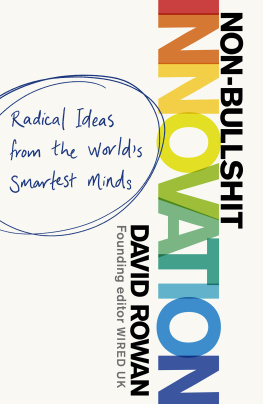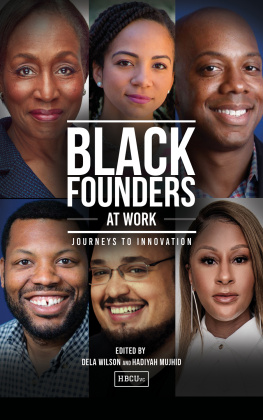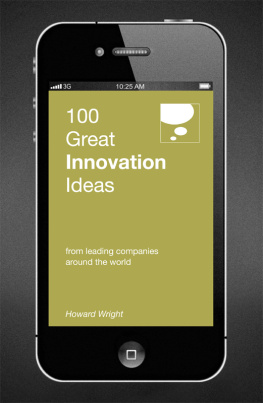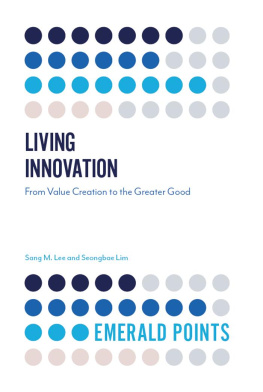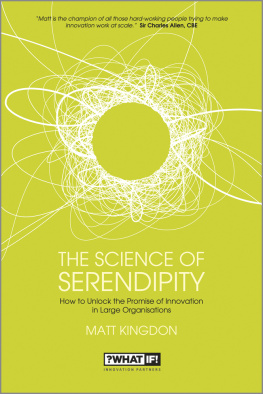

CONTENTS
About the Author
David Rowan was founding editor-in-chief of WIREDs UK edition and technology columnist for The Times, GQ, Cond Nast Traveller and the Sunday Times. He travels excessively to meet crazy-driven startup entrepreneurs who are reinventing every industry in fascinating ways. Fortune 100 companies regularly hire him to explain how these startups plan to kill their businesses, and he invests these speaking fees holistically in startups that plan to kill the corporates businesses. David founded Voyagers.io to build meaningful community through magical travel adventures. And hes still searching for the future.
For Sarah
INTRODUCTION
How my despair at the innovation industry prompted a global quest
I finally hit the limit of my tolerance for corporate innovations spuriously sophisticated bullshit at the opening networking party for Innova-Con the annual convention of the International Association of Innovation Professionals (IAOIP). Its late February 2018 and Im at a drinks reception in a room above Washington DCs International Spy Museum, being handed a red cocktail napkin on which a set of interlinked circles has just been hastily drawn. Above the hubbub Brett Trusko, the associations clean-cut president and CEO, is on a mission to convince me that innovation can be reduced to a repeatable formula. Hes labelled the three overlapping circles on the napkin Social Science, Hard Science and Business, and as a small crowd gathers Trusko proceeds to explain that the drawing represents the scientific formula for innovation.
Were talking about the intersection between social science, ethnography, that kinda stuff, he says with conviction, warming to the delegates attention. Theres hard science, which is engineering, math, et cetera; and business. This in the middle he places his pens nib on the segment where they overlap is where innovation science exists. And this is where weve got a problem because in universities, all three are siloed.
Trusko, a genial man in his mid-fifties with the targeted charm of a door-to-door brush salesman, warns me that such silos are blocking innovation. How many times does an engineer sit in his office, and a businessperson comes in and says, Hey, we should build a bridge between New York and London, it will be awesome! The engineer says this person is stupid. Then the engineer comes and says, I just invented the greatest laptop ever, twice as fast as anything that exists now, and it only costs $80,000 to manufacture. The businessperson says, What?! That is where Truskos association fits in. Through its webinars, its certification programme, its online iBoK (Innovation Body of Knowledge) and transformation-leader events such as Innova-Con, the IAOIP sees itself as breaking down those walls, empowering the change-makers, and pushing the world forward using the magical formula on the napkin.
Over two days, I will learn all about the supposed science of innovation and the many ways Trusko has positioned his organization as the home of innovation thought leadership. Trusko, a former accountant, business consultant and data scientist based in Sugar Land, Texas, came to the innovation business when he took over the International Journal of Innovation Science almost a decade ago. He had been watching TV one evening when he saw three commercials from companies that were all claiming to be innovators; one was for Dole, a fruit company, which made him wonder how the hell fruit could be innovative unless they were growing purple bananas. I thought, we have to professionalize this, he recalls. There are more people with innovation in their job titles than accountants, he says, yet too often theyre unaware of the science that could bring them repeatable results. Only last week he was in Saudi Arabia and Abu Dhabi, where three companies in three days asked him to conduct workshops for their chief innovation officers and explain to them what innovation actually is. I had four hours to tell them its about culture, strategy, training, having the right people. I said, Im going to orient you to whats going on in your organization. I call it giving them an invitation to innovate.
Demand for Truskos services is booming. After four years, the IAOIP, registered as a non-profit, has 1,600 members in eighty-five countries, with Trusko boldly forecasting 10,000 by 2020, and 20,000 by 2023. Members can take courses to gain skills in the science of innovation, working towards professional qualifications such as a Certified Manager of Innovation ($400 to pass) or a Certified Chief Innovation Officer ($1,150). They pay just $110 for the Global Innovation Science Handbook and a subscription to the International Journal of Innovation Science, whose combined retail value is normally $550. They can also access the newly launched IAOIP Academy, a learning management system offering online courses, and they can buy places on immersion tours of Silicon Valley. And, as mentioned, there are the webinars this months is titled How to Identify Blockers and Amplifiers for Innovation. Trusko, meanwhile, is also building a speakers bureau and working on a book, provisionally titled Sex Wasnt Invented in Silicon Valley.
As I look around the party, I notice one gentleman wearing a Bluetooth hands-free phone earpiece as he socializes. A friendly lady with a southern accent hands me a beer bottle, and I try to twist off the resistant cap. Be innovative! Put the cap on the edge of the table and hit it, advises Jon Monett, a retired CIA technical operations specialist and US Air Force veteran who has just lectured at the Spy Museum about innovating on the fly. When Monett retired, he started a security and intelligence advisory company and established a non-profit called Quality of Life Plus at Cal Poly in San Luis Obispo, California, to foster innovations that improve the quality of life of those injured in the line of duty. Our conversation turns to tools and strategies for innovating, and I learn about TIPS the theory of inventive problem-solving, based on a Soviet analytics and forecasting tool.
Bretts wife Kirsten Trusko, who runs her own advisory firm (her business card promises Deeds not Words), joins our group and tells me that most corporate innovators have arrows in their back and dont survive. Thats why the association is developing practical tools to support the innovators, and is working with the International Organization for Standardization to develop ISO 279, the global standard of innovation management. Kirsten introduces me to John Wolverton, a retired US Air Force commander now with Sandia National Laboratories, who earlier today led a certification exam review session for Innova-Con delegates on the subject of innovation tools and methodologies.
Wolverton, tall, long-haired, and with a booming voice, typifies the hunger for stimulating ideas and yet the jaded expectation of their unscientific misapplication that I encounter repeatedly at the conference. He has, for instance, some very strong views on why most corporate innovators get killed. Have you read The 48 Laws of Power [by Robert Greene]? he asks me. Whats the first law? Never outshine the master. Every time I succeed as an innovator, its when I have a boss who is much smarter than me. Law number three? Conceal your intentions if you want to survive. As I put down my beer and grab my notebook, Wolverton shares some of what hes learned as an innovator and innovation trainer in an intense ten-minute booklist-filled, anecdote-packed, hard-to-interrupt stream of observations:
Next page
